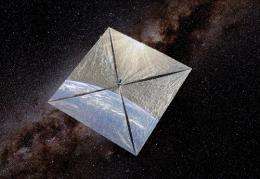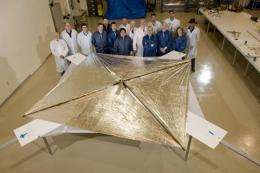Setting sail in the sun

Propelled by sunlight pressure, large lightweight sails made of ultrathin aluminum-coated plastic could one day take probes to the edge of our solar system and other stars.
By rigging large pieces of cloth atop boats, early explorers harnessed the wind to voyage across oceans. Now, modern space explorers want to use sails to send spacecraft to the far reaches of the solar system and beyond. These sails will be made of large, ultra-thin gossamer plastic sheets that, instead of wind, will be propelled using sunlight.
Light particles, or photons, exert a small pressure when they bounce off a reflective surface. Ever since James Maxwell proved that light exerts pressure in the 1860s, space exploration visionaries have talked about solar sailing. Exciting new developments this year are making their vision a reality.
In May, the Japanese Space Exploration Agency successfully launched IKAROS, the first-ever spacecraft to use solar sail for propulsion in space. The spacecraft finished unfurling its sail in June and is now accelerating toward Venus under solar pressure. Two more solar sail launches are on the horizon: NASA plans to launch a sail this fall, while the Planetary Society is aiming for a launch in 2011.
At the second International Symposium on Solar Sailing (ISSS 2010), which was held at the New York City College of Technology in July, 60 experts from around the world unanimously agreed that “solar sail technology is viable for space flight operations.” The panel recommended speeding up development and testing the technology.
“Solar sailing is the only known technology we have on Earth that will someday take us to the stars,” says Louis Friedman, executive director of The Planetary Society.
Speedy Sunlit Sails
Sail-propelled spacecraft could be used to monitor the Earth or hover close to the Sun to study solar storms and flares. They also could be used to adjust the orbits of satellites circling the Earth. But their true reach and potential lie farther away: experts believe they are the best propulsion system for exploring the outer edges of the solar system and someday other stars. That is because unlike rockets, they don’t require fuel and they gain speed constantly as long as light hits them; they can eventually move spacecraft much faster than a rocket.

“If you want to go really quickly to the outer edge of the solar system you’d want to use a solar sail,” says Les Johnson, deputy manager of The Advanced Concepts Office at NASA’s Marshall Space Flight Center. “A chemical system [such as] a rocket would run out of gas long before you get there. With solar sails, as long as you’ve got the Sun you can keep going.”
Today’s solar sails are typically made of aluminum-coated plastic films with a thickness a fraction that of a trash bag. Other lightweight materials such as alumina or carbon fiber are also being tested. To capture as much pressure from sunlight as possible, they need to be big. The Planetary Society’s Cosmos-1, which did not reach orbit due to a rocket failure, had a surface area of 600 square meters, about one and a half times the size of a basketball court.
Going to the fringes of the solar system would require very large sails. Johnson imagines next-generation sails would have to be hundreds of meters on a side. They would be deployed close to the Sun to gain thrust and build up immense speed so they could coast the rest of the way through the solar system.
In three years, a solar sail could reach speeds of 150,000 miles an hour. At that speed, it could reach Pluto in less than five years. It took NASA’s Voyagers over 12 years to reach a similar distance. The latest spacecraft to head toward Pluto, NASA’s New Horizons mission, will take nine years to reach its destination using a combination of rocket propulsion and gravity-assistant maneuvers.
Friedman believes that a sail-propelled spacecraft for exploring the Kuiper Belt is possible within the next ten years. Beyond the orbit of Jupiter, the energy from sunlight gets too weak to keep sails accelerating, so to go beyond our solar system, a craft could need added thrust. For that, he says, light could be provided by a solar-powered laser placed in orbit around the Sun at a mid-point within the solar system.
Setting Sail for the Future
NASA’s first experience with the concept of solar sailing came in 1974 with the Mariner 10 spacecraft, which was designed to fly by Venus and Mercury. When the craft’s direction needed to be changed and it had run out of gas for its jets, controllers turned its solar panels to face the Sun and change the spacecraft’s direction with solar pressure.
Between 2001 and 2005, NASA built two 20-meter sails that were successfully tested on the ground under vacuum conditions. But funding for the projects fell through in 2005. About that same time, affordable compact nanosatellites called CubeSats appeared on the scene, presenting a low-cost opportunity to launch a solar sail.

The result was NanoSail-D, a diamond-shaped sail three meters on a side that was made of four triangular blades and was packed into a 4.5-kilogram spacecraft about the size of an airplane carry-on bag. In 2008, NanoSail-D was launched aboard a Falcon-1 rocket that failed to reach orbit.
Scientists at NASA’s Marshall Space Flight Center plan to launch NanoSail-D again this fall. Meanwhile, the Planetary Society is building LightSail-1, a 32 square meter sail that will weigh less than 5 kilograms.
Until the launch of the Japanese IKAROS spacecraft this May, no solar sail had ever been deployed in space primarily for propulsion. IKAROS has a solar power sail that uses the Sun’s pressure for propulsion and embedded thin-film solar cells to generate power. The square sail with 10 meter sides was deployed and is kept flat because of the craft’s spinning motion and weights attached to its four corners. This is unique to the Japanese design, Friedman says, calling the mission a “great achievement and major step toward solar sail flight.”
The LightSail and NanoSail, by contrast, deploy the sail using a rigid mast or boom to which the sail’s blades are attached. This more traditional design tends to be heavier than the IKAROS design.
Johnson says that the biggest challenge lying ahead for NASA engineers is to make the booms lighter. The lower the sail’s overall mass, the more it accelerates from the Sun’s force. Researchers are now looking for tough, lightweight materials for the support structure.
Much as the explorers of the past used sails to search for ‘new worlds’ on the uncharted seas, perhaps one day solar sail technology will allow humans to travel beyond our solar system and visit new and alien worlds elsewhere in our galaxy.
Source: Astrobio.net, by Prachi Patel


















